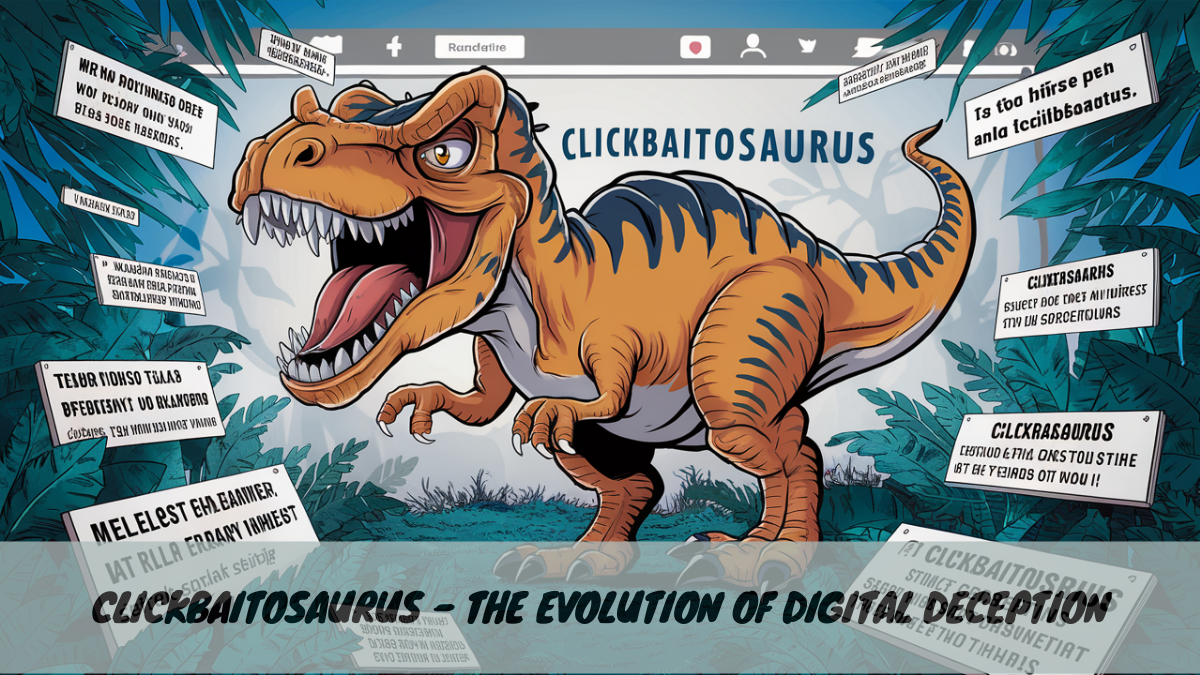Clickbaitosaurus – The Evolution of Digital Deception
Introduction to Clickbaitosaurus: Unraveling the Origins
In the vast digital landscape, the term “clickbait” is well-known and often dreaded by online users. It refers to the sensationalist headlines or thumbnails that lure readers into clicking on a link, only to discover that the content is often disappointing or irrelevant. But what happens when clickbait evolves, becoming more pervasive, strategic, and sophisticated? Enter the concept of “Clickbaitosaurus,” a term that encapsulates the aggressive, prehistoric nature of modern digital deception.
Clickbaitosaurus is the evolved form of clickbait, using deceptive headlines and thumbnails to lure users. It drives quick traffic but damages trust and long-term audience engagement.
This article explores the rise of Clickbaitosaurus, its impact on online content, and what this evolution means for users and content creators alike.
1. The Rise of Clickbaitosaurus: How Digital Deception Evolved
1.1 The Birth of Clickbait
The origins of clickbait can be traced back to the early days of online content when websites began to realize the importance of traffic. Headlines were crafted to be attention-grabbing, often stretching the truth or omitting crucial details to compel users to click. The goal was simple: more clicks meant more ad revenue.
1.2 From Clickbait to Clickbaitosaurus
As digital marketing strategies evolved, so did clickbait. The once simple and crude methods of luring users have transformed into sophisticated tactics designed to exploit human psychology. This evolution has given birth to what we now refer to as Clickbaitosaurus. This term embodies the aggressive, relentless, and often predatory nature of these deceptive tactics.
1.3 Characteristics of Clickbaitosaurus
Clickbaitosaurus is not just about sensational headlines. It represents a broader range of deceptive practices, including:
- Misleading Thumbnails: Images that suggest content unrelated to the actual material.
- Ambiguous Headlines: Titles that create curiosity but lack specificity, leading users to click out of sheer curiosity.
- False Promises: Content that promises exclusive information or sensational revelations but delivers nothing substantial.
- Manipulative Storytelling: Articles or videos that stretch a simple story into a long narrative with little payoff, designed solely to keep the viewer engaged for longer periods.
2. The Impact of Clickbaitosaurus on Online Content
2.1 Erosion of Trust
One of the most significant impacts of Clickbaitosaurus is the erosion of trust between content creators and their audiences. As users become more aware of these tactics, they grow increasingly skeptical of online content. This skepticism can lead to a decline in user engagement and trust, which is detrimental to both creators and platforms.
2.2 The Dilution of Quality Content
Clickbaitosaurus has also contributed to the dilution of quality content. As more creators adopt these tactics to chase clicks, the overall quality of online content suffers. Thoughtful, well-researched articles are often overlooked in favor of sensationalist pieces that offer little value. This shift has made it harder for genuine content to stand out in an increasingly crowded digital space.
2.3 The Spread of Misinformation
In some cases, Clickbaitosaurus can lead to the spread of misinformation. By prioritizing sensationalism over accuracy, these tactics can amplify false or misleading information. This is particularly concerning in areas such as health, politics, and social issues, where the spread of misinformation can have serious consequences.
2.4 Impact on Content Platforms
Clickbaitosaurus has also forced content platforms to evolve. Social media sites, search engines, and video platforms have had to implement stricter guidelines and algorithms to combat clickbait. However, this has also led to new challenges, such as the potential for legitimate content to be unfairly penalized.
3. Why Clickbaitosaurus Persists: The Psychology Behind the Click
3.1 The Power of Curiosity
One of the primary reasons Clickbaitosaurus persists is because it taps into the natural human instinct of curiosity. Humans are wired to seek out new information, and clickbait exploits this by creating headlines or thumbnails that promise something intriguing or surprising. Even when users suspect that the content may not deliver, the urge to satisfy curiosity can be overwhelming.
3.2 Fear of Missing Out (FOMO)
Another psychological factor at play is the fear of missing out (FOMO). Clickbait often capitalizes on this by suggesting that the content contains exclusive or time-sensitive information. Users click because they don’t want to miss out on something potentially important or entertaining, even if the content is ultimately disappointing.
3.3 The Reward System
Clickbaitosaurus also takes advantage of the brain’s reward system. When users click on a link, there is a brief moment of anticipation and excitement, driven by the hope that the content will be rewarding. Even when the content fails to deliver, the brain remembers the momentary thrill of the click, making users more likely to fall for clickbait again in the future.
4. How to Identify and Avoid Clickbaitosaurus
4.1 Red Flags to Watch For
To protect yourself from Clickbaitosaurus, it’s essential to recognize the common signs of clickbait:
- Overly Sensational Headlines: Be cautious of headlines that seem too good (or bad) to be true. If a headline promises something that seems exaggerated or unbelievable, it’s likely clickbait.
- Vague Promises: Headlines that use phrases like “You Won’t Believe What Happened Next” or “This Simple Trick Will Change Your Life” without providing specifics are often designed to lure you in without delivering on the promise.
- Manipulative Thumbnails: If the thumbnail image doesn’t seem to match the content of the title or appears overly dramatic, it could be a sign of clickbait.
4.2 Strategies for Avoiding Clickbait
- Read Before Clicking: Before clicking on a link, try to find more information about the content. Sometimes a quick search or preview can reveal whether the content is legitimate or just clickbait.
- Check the Source: Reputable sources are less likely to use clickbait tactics. If the content is from a lesser-known site or a source with a history of sensationalism, proceed with caution.
- Use Browser Extensions: There are browser extensions available that can help identify and block clickbait. These tools analyze headlines and content to determine whether a link is likely to be clickbait.
5. The Ethics of Clickbaitosaurus: Balancing Engagement and Integrity
5.1 The Moral Dilemma for Content Creators
For content creators, Clickbaitosaurus presents a moral dilemma. On one hand, clickbait can drive significant traffic and engagement, which is often necessary for success in a competitive digital environment. On the other hand, relying on deceptive tactics can damage a creator’s reputation and erode trust with their audience.
5.2 The Role of Platforms
Content platforms also face ethical challenges when it comes to Clickbaitosaurus. While these platforms benefit from increased traffic and engagement, they also have a responsibility to ensure that users are not being misled or exploited. This has led to the development of algorithms and policies designed to reduce the prevalence of clickbait, but these measures are not always effective.
5.3 Finding a Balance
The key to combating Clickbaitosaurus lies in finding a balance between engagement and integrity. Content creators can use attention-grabbing headlines and thumbnails without resorting to deception by ensuring that the content delivers on its promises. Similarly, platforms can encourage high-quality content by rewarding accuracy and relevance rather than just clicks.
6. The Future of Clickbaitosaurus: Will It Survive or Go Extinct?
6.1 The Evolution of User Awareness
As users become more aware of Clickbaitosaurus and its tactics, they are likely to become more discerning in their online behavior. This increased awareness could lead to a decline in the effectiveness of clickbait, forcing content creators to adopt more honest and transparent practices.
6.2 Technological Advances
Advances in technology, particularly in the fields of artificial intelligence and machine learning, could also play a role in the future of Clickbaitosaurus. Algorithms that can accurately detect and penalize clickbait may become more sophisticated, making it harder for deceptive content to thrive.
6.3 The Role of Regulation
In some cases, government regulation may be necessary to curb the worst excesses of Clickbaitosaurus. While regulation is a complex and often controversial topic, there is a growing recognition that some form of oversight may be needed to protect users from deceptive practices.
6.4 The Potential for a Rebirth
While Clickbaitosaurus in its current form may eventually go extinct, there is always the potential for a new form of digital deception to emerge. Just as clickbait evolved into Clickbaitosaurus, the future may bring new challenges as content creators continue to seek ways to capture and hold users’ attention.
7. How Clickbaitosaurus Affects Content Creators and Marketers
7.1 The Temptation of Easy Clicks
For many content creators and marketers, Clickbaitosaurus presents an easy way to generate traffic and boost engagement. The temptation to use sensational headlines and thumbnails can be strong, especially in highly competitive niches where visibility is crucial.
7.2 Long-Term Consequences
However, the long-term consequences of relying on Clickbaitosaurus can be damaging. While these tactics may bring short-term gains, they can also lead to a loss of credibility and trust. Over time, audiences may become disillusioned and move on to more trustworthy sources, leaving creators and marketers with diminishing returns.
7.3 The Importance of Building Trust
For sustainable success, it’s essential for content creators and marketers to focus on building trust with their audience. This means delivering on promises, providing valuable content, and avoiding deceptive tactics. In
the long run, trust is far more valuable than a fleeting increase in clicks.
8. Case Studies: Clickbaitosaurus in Action
8.1 Case Study 1: The Rise and Fall of a Viral Sensation
In this case study, we examine a website that quickly rose to fame using Clickbaitosaurus tactics, only to see its traffic plummet when users caught on. This example highlights the short-lived nature of success built on deception.
8.2 Case Study 2: A Content Creator’s Redemption
This case study explores how a popular content creator initially relied on Clickbaitosaurus to grow their audience but eventually shifted to more ethical practices. The result was a more engaged and loyal following, proving that integrity can pay off.
8.3 Case Study 3: A Platform’s Struggle with Clickbait
Here, we look at how a major content platform attempted to combat Clickbaitosaurus through algorithm changes and policy updates. The case study provides insights into the challenges platforms face in balancing user engagement with content quality.
9. Strategies for Content Creators to Combat Clickbaitosaurus
9.1 Focus on Quality Over Quantity
One of the most effective ways to combat Clickbaitosaurus is to prioritize quality content. By focusing on creating valuable, informative, and engaging content, creators can build a loyal audience that doesn’t need to be tricked into clicking.
9.2 Transparent Headlines and Thumbnails
Content creators should strive to use transparent headlines and thumbnails that accurately represent the content. This builds trust with the audience and ensures that users know what to expect when they click on a link.
9.3 Engaging Without Deception
There are ways to engage audiences without resorting to Clickbaitosaurus tactics. Creators can use storytelling, humor, and emotional appeal to draw in users while still delivering on their promises.
10. FAQs About Clickbaitosaurus
10.1 What is Clickbaitosaurus?
Clickbaitosaurus is a term that refers to the evolved and more aggressive form of traditional clickbait. It encompasses a range of deceptive practices designed to lure users into clicking on content that may be misleading or irrelevant.
10.2 How Can I Avoid Falling for Clickbaitosaurus?
To avoid Clickbaitosaurus, be wary of sensational headlines, vague promises, and manipulative thumbnails. Always check the source of the content and read previews or summaries before clicking.
10.3 Why Do Content Creators Use Clickbaitosaurus?
Content creators may use Clickbaitosaurus tactics to drive traffic and engagement quickly. However, these tactics often come at the cost of long-term trust and credibility.
10.4 What Are the Consequences of Using Clickbaitosaurus?
The consequences of using Clickbaitosaurus can include loss of trust, damage to reputation, and a decline in audience engagement over time. It can also lead to the spread of misinformation.
10.5 Will Clickbaitosaurus Eventually Go Extinct?
As users become more aware of Clickbaitosaurus and technology advances, the effectiveness of these tactics may decline. However, there is always the potential for new forms of digital deception to emerge.
Conclusion: The Future of Clickbaitosaurus in the Digital Jungle
Clickbaitosaurus represents the darker side of digital content creation, where the pursuit of clicks often overrides the commitment to quality and integrity. As users become more discerning and platforms evolve to combat deceptive practices, the reign of Clickbaitosaurus may eventually come to an end. However, the lessons learned from its rise are invaluable. Content creators and marketers must prioritize trust and transparency if they want to thrive in the ever-changing digital landscape. By focusing on quality content and ethical practices, we can ensure that the next evolution of online content is one that benefits both creators and consumers alike.







